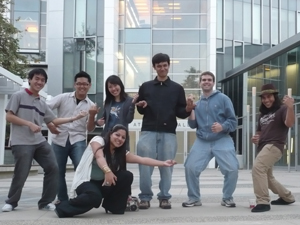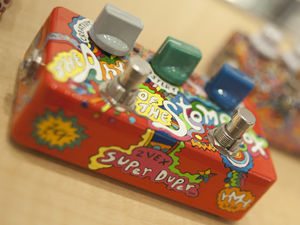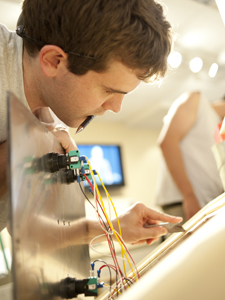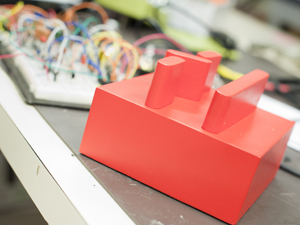UCSD Undergrads Collaborate with Museum of Making Music
By Tiffany Fox, (858) 246-0353, tfox@ucsd.edu
San Diego, Calif., June 3, 2010 — Engineers expect to be called upon to do all manner of hands-on work to advance their careers, but Saura Naderi never expected she'd be called upon to do the hand jive.
|
That's just what happened when Naderi, an electrical engineering alumna of the University of California, San Diego, attended a recent concert at Carlsbad's Museum of Making Music. The performer asked if anyone in the audience knew the classic hand dance, and suddenly Naderi was onstage demonstrating. She was such a big hit that people flocked to congratulate her during the intermission — including Museum Curator Tatiana Sizonenko.
Naderi, who launched UCSD's interdisciplinary, student-centric MyLab program this year, jumped at the chance to ask Sizonenko if the members of MyLab could collaborate with the Museum on a future project.
The result is "The Art of the Stompbox," an exhibition that highlights the development and use of effects pedals (like Jimi Hendrix's use of the wah-wah pedal) in American roots music and the American music scene. MyLab undergrads affiliated with UCSD's Jacobs School of Engineering designed several of the interactive components for the modern effects pedals, including the internal circuitry, controller panel, filtering software and the pedal housing (RMS Laser actually built the housing). UCSD visual arts students contributed artistic work to complement a display of some of the most acclaimed contemporary pedal painters from the past two decades.
"I'm not much of a musician; I just know that's what gets people going," said Naderi, who started MyLab as a way to give aspiring engineers the opportunity to research, design and implement their own ideas. "Music, art and games are things people would do regardless of whether or not they're engineering-related. I try to choose projects that get people excited, and this collaboration naturally grew from that."
|
Both Saderi and Sizonenko are affiliates of the UCSD division of the California Institute for Telecommunications and Information Technology (Calit2). Sizonenko, who is a doctoral candidate in art history at UC San Diego and an affiliate of Calit2's Center of Interdisciplinary Science for Art, Architecture and Archeology (CISA3), called the exhibition a 'deep interactive display of visual science.'
"My vision was to show how contemporary artists use these devices in their music, where the artistic gesture is the use of the stompboxes and the sound is like paint," explained Sizonenko of the exhibition, which opened yesterday and continues through Sept. 30 (the opening reception for the exhibition is June 12). "We're trying to show that electronic music is an artistic expression where the equipment serves as an extension of the musician's hands and mind."
|
UCSD Students involved with the Stompbox project are: Justin Huang, an electrical engineering (EE) major, Tomas Durkin, an Interdisciplinary Computing and the Arts (ICAM) major, Minho Han (EE) , Sherry Li (EE), Andrew Vargas (ICAM) and Jeff Wurzbach (EE).
ICAM major Nichol Bernardo designed housing for the pedals. Roland BOSS and BBE Sound donated pedals to MyLab to give the students experience working with the devices.
Following on the heels of "The Art of the Stompbox" will be a series of further collaborations between MyLab and the Museum that stemmed from a project Naderi dubbed "A Night at the Museum Trade Show 2010."
"I wanted to give the students in MyLab the feeling of participating in a mock trade show, where they would be the ones building and marketing the device prototypes and 'customers' would decide which ones they wanted to buy," Naderi added. The customer in this case was the Museum of Making Music, which chose six of the seven student-designed interactive devices and may implement them in the coming months.
The projects include:
• A playback system that lets visitors use faders to interact with song samples and instrumentation
• A device that gives museum visitors the choice to play a song using wax cylinders, wire, vinyl, reel-to-reel tape and other media
|
• A piano walkway that functions as a giant piano, where museum visitors walk across the keys to play music
• LED speakers that blink in time to music
• Three-sided informational posters about instrument manufacturers that rotate in the presence of visitors, and slow as a person approaches.
Students involved with these projects include Wurzbach (who participated in the Stompbox project); Joey Ma (ICAM); Daniel Arias (EE); Jamie Hauk (ICAM); Karl Magnus Delight (EE); Eileen Yu (EE) and Jose Ruvalcaba (EE).
Although the students have built prototypes of each of their projects, the MMM will likely select a design company to built the implemented versions. Students will play a role in making the devices more robust, however, and museum visitors will also have a chance to interact with the devices to decide which among them will become a part of the museum's permanent collection.
Noted Sizonenko: "Museums usually go to design companies to commission ideas, but we felt that since we have such a strong engineering community in San Diego, we would see if they come up with interesting and suitable ideas. By working with MyLab, we are giving a younger generation of people — who will be the next generation of museum-goers — the chance to design something unique."
Media Contacts
Tiffany Fox, (858) 246-0353, tfox@ucsd.edu
Related Links





